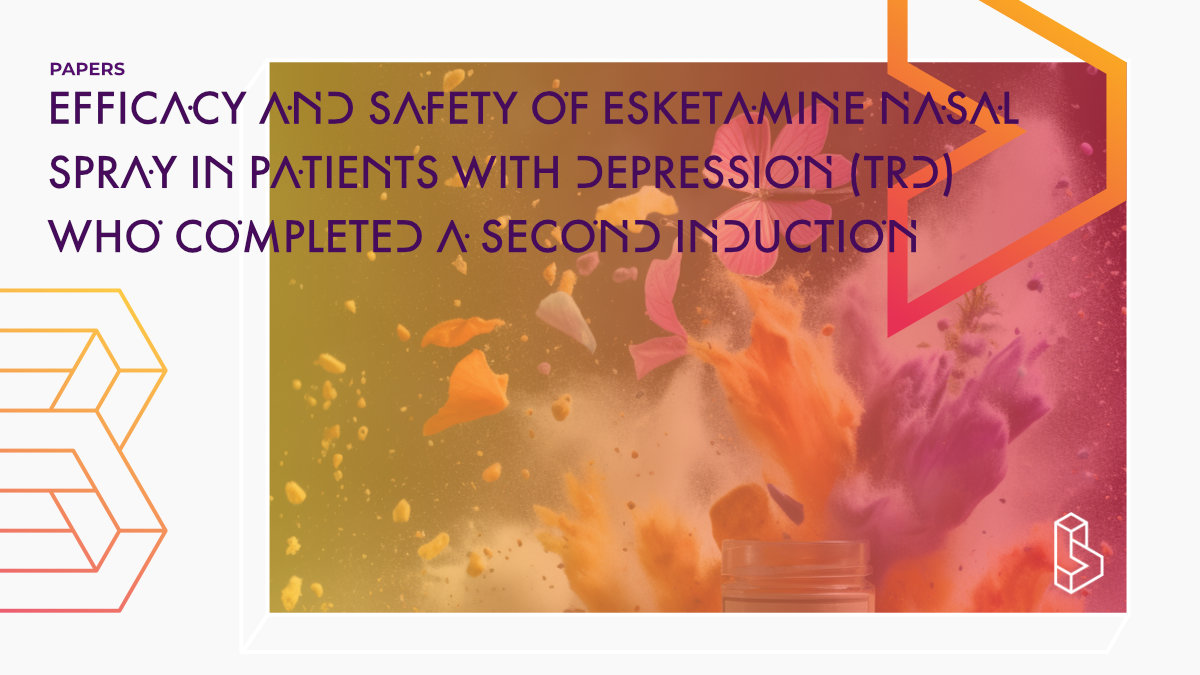This subgroup analysis of SUSTAIN-3 (n=96) studies patients with treatment-resistant depression (TRD) who received a second induction and maintenance treatment with esketamine nasal spray (ESK) plus oral antidepressant (AD) after a relapse in SUSTAIN-1. Results show substantial improvements in depressive symptoms in both ESK+AD and AD+placebo groups, with MADRS response rates of 71.9% and 73.4%, and remission rates of 62.5% and 60.9%, respectively. During the induction and optimization/maintenance phases, 58.3% and 83.3% of patients experienced a treatment-emergent adverse event, but no patients discontinued due to an adverse event.
Abstract of Efficacy and Safety of Esketamine Nasal Spray in Patients with Depression (TRD) Who Completed a Second Induction Period
“Background: Treatment-resistant depression (TRD) is a chronic illness requiring long-term treatment. Esketamine nasal spray (ESK) has been studied in several long-term trials of patients with TRD, including SUSTAIN-1 (NCT02493868) and SUSTAIN-3 (NCT02782104). This subgroup analysis of SUSTAIN-3 evaluated patients with TRD who received a second induction (IND) and maintenance treatment with ESK plus oral antidepressant (AD) after a relapse in SUSTAIN-1.
Methods: Patients aged 18-64 years who achieved stable remission or response with ESK and subsequently relapsed after randomization to continue ESK or switch to placebo nasal spray (PBO) in SUSTAIN-1 and entered the IND phase of SUSTAIN-3 were included in this interim analysis. Response (≥50% improvement in total score from baseline for Montgomery-Åsberg Depression Rating Scale [MADRS] and Patient Health Questionnaire 9-item [PHQ-9]), remission (MADRS score ≤12; PHQ-9 total score <5), changes in depression rating scores (measured as mean change from baseline), and safety were evaluated (incidence of treatment-emergent and serious adverse events [AE]).
Results: Of the 96 eligible patients who entered IND in SUSTAIN-3, 32 (33.3%) were taking ESK+AD at the time of relapse in SUSTAIN-1 and 64 (66.7%) were taking AD+PBO. Substantial improvements in depressive symptoms were observed over the second IND phase in both groups and were maintained over the optimization/maintenance (OP/M) phase. MADRS response rates following a second IND were 71.9% and 73.4% for previously relapsed (PR) ESK+AD and PR-AD+PBO, respectively; remission rates were 62.5% and 60.9%, respectively. During the IND and OP/M phases, 58.3% and 83.3% of patients experienced a treatment-emergent AE, respectively. No patients discontinued due to an AE during the second IND.
Conclusions: Patients with TRD benefitted from receiving a second IND and maintenance treatment with ESK and no new safety signals were identified.”
Authors: Meredith Castro, Samuel T. Wilkinson, Rayan K. Al Jurdi, Mary Pat Petrillo, Naim Zaki, Stephane Borentain, Dong Jing Fu, Ibrahim Turkoz, Liping Sun, Brianne Brown & Patricia Cabrera
Summary of Efficacy and Safety of Esketamine Nasal Spray in Patients with Depression (TRD) Who Completed a Second Induction Period
Major depression affects approximately 8.9 million adults in the United States, including approximately 2.8 million adults who exhibit treatment-resistant symptoms. Patients with treatment-resistant depression often experience prolonged depressive episodes, which can lead to treatment discontinuation prior to reaching recovery.
Patients with treatment-resistant depression who previously responded to esketamine nasal spray (ESK) plus an oral antidepressant and experienced a relapse benefitted from receiving a second induction and maintenance treatment with ESK. ESK was generally well tolerated and no new safety signals were identified.
The SUSTAIN-3 study is a long-term, open-label, phase III study evaluating the efficacy, safety, and tolerability of ESK in patients with TRD. A subset of patients who relapsed in SUSTAIN-1 were eligible to receive a second induction followed by maintenance treatment with ESK.
Find this paper
https://doi.org/10.1007/s40263-023-01026-3
Open Access | Google Scholar | Backup | 🕊
Cite this paper (APA)
Castro, M., Wilkinson, S. T., Al Jurdi, R. K., Petrillo, M. P., Zaki, N., Borentain, S., ... & Cabrera, P. (2023). Efficacy and Safety of Esketamine Nasal Spray in Patients with Treatment-Resistant Depression Who Completed a Second Induction Period: Analysis of the Ongoing SUSTAIN-3 Study. CNS drugs, 1-9.
Study details
Compounds studied
Ketamine
Topics studied
Treatment-Resistant Depression
Depression
Study characteristics
Follow-up
Re-analysis
Participants
96
Humans

